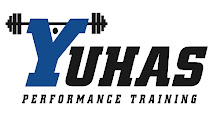A couple of weeks ago on Sports Talk with Bill and Mike, I gave my weekly radio spot and the topic was "sport-specific" training. Anyone who knows me or trains with me knows I dislike the term "sport-specific". For the most part, this title is a bit of a misnomer as there is really no such thing. Maybe the correct title should be "athlete-specific" training?
Many parents and kids come to my business looking for the special baseball-specific or soccer-specific programs to get them to the next level. It is probably in my best interest to just say, "sure, we do volleyball specific training here, just sign up and your daughter will be jumping through the roof in 6 short weeks!" Unfortunately, I am kind of like the Agent Mulder of Strength and Conditioning, you know, the truth is out there. I have a bad habit of telling folks what they need to hear as opposed to what they want to hear; is that a bad thing? After all, I have been doing this for the better part of 20 years.
When it comes to exercises, people love to hear certain exercises are better for certain sports. In reality, it is better to say there are some exercises that are worse for athletes who play particular sports. Many coaches will adhere to "old school" mentality and force their athletes to perform exercises that may not be suitable for their body type. The traditional squat exercise may not be suitable for basketball players or tall offensive lineman as their body segments may be out of proportion and performing this exercise may put them at a higher risk of a training injury and that is a major violation of the prime directive in strength and conditioning.
The thing is, there are no "magical" exercises that help you hit a baseball harder or throw a lacrosse ball farther. I once had a mother of a high school tennis player pull her daughter out of the program simply because we did not do any "tennis-specific" exercises that mimicked hitting a tennis ball! Others have asked what kind of special drills do we perform to get kids faster. Getting faster is the net effect of the total training program, as is hitting a baseball farther or jumping higher.
Our football athletes may be doing the same lower body lifts as our softball athletes, its just that the football player maybe doing it with 5 times the weight, or vice versa! You see, we may have an experienced varsity softball player performing a rear foot elevated split squat with 135 pounds on the bar but have a sophomore football player doing the same exercise with an unloaded bar. Both athletes are looking to get faster and stronger and more powerful and are both performing an exercise to help develop lower body strength and power and improve acceleration, its just tailored to their ability levels.
The essence of a good strength and conditioning program is to teach athletes how to train properly and safely and reduce the chance of getting injured as well as enhancing performance. Furthermore, we are trying to make them more efficient in their ability to move on the field, ice, or court. We base our training on addressing what our athletes need to work on.
At Yuhas Performance Training we train clients to become better overall athletes. All athletes (and non-athletes for that matter) need to train the 5 major components of athletic development: stability, mobility, strength, power and conditioning. These components are assessed individually and the program is established to emphasize the weakest component while at the same time not neglecting the others. For example, an athlete might enter my facility with outstanding speed and excellent conditioning levels, but lack strength and power. By placing a greater emphasis on getting the athlete stronger we can then get them more powerful and thus take their speed to an even higher level!
The only component that approaches the realm of sport specificity would be the conditioning component. In other words, our football athletes will condition differently than our soccer players or our baseball players. Why? Because the energy demands of these sports are quite different. Prehabilitation exercises also tend to take on a sport-specific identity in that we will program certain exercise to address the most commonly injured areas in certain sports. This may be specific rotator cuff exercises for overhead athletes or more groin work for hockey players.
The take home message: don't get caught up in thinking there are specific exercises that make you better at performing some sort of sport skill. Understand that training is individual-specific and that developing overall athleticism is the goal of the training program.
Wednesday, January 27, 2010
Subscribe to:
Post Comments (Atom)



No comments:
Post a Comment